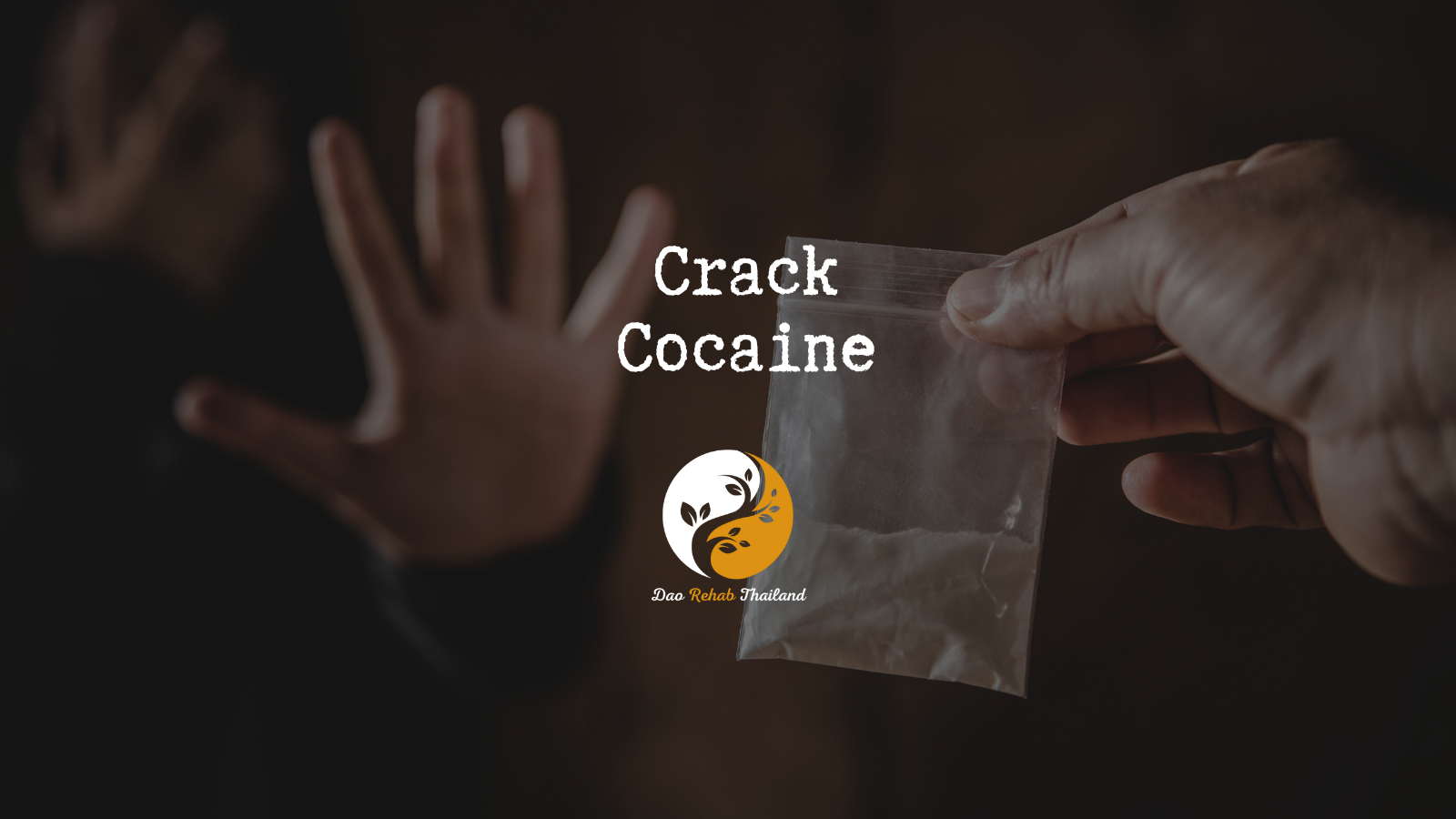
Crack Cocaine Detoxification at a Holistic Center in Thailand:
Crack Cocaine
“Turning the impossible into possible”

"Detox from Crack Cocaine at a Luxury Holistic Center in Thailand and Israel"

Detox from Crack Cocaine
Crack Cocaine is a processed form of cocaine that can be smoked. Unlike powdered cocaine, crack is created by heating cocaine with water and a base (usually baking soda) to form solid crystals that can be smoked. The drug is called “crack” due to the cracking sound it makes when heated.
"Holistic Center for Trauma, Addiction, and Mental Imbalance Treatment in Thailand"
“Come to the beginning of your journey to freedom from addiction to alcohol, drugs, and pills, and rediscover your life within the serene embrace of DaoTherapy Rehab in Thailand—where holistic healing meets empowering recovery.”
DaoTherapy Holistic Rehab
Key Elements of Crack Cocaine Detox:
Medical Supervision: Crack Cocaine detox must be conducted under medical supervision, as the body may experience withdrawal symptoms. These can include nausea, anxiety, muscle aches, and insomnia. A medical team will monitor and manage these symptoms to ensure the patient’s safety and comfort.
Holistic Therapies:
Holistic Therapies: Many detox programs incorporate holistic therapies such as mindfulness, yoga, and meditation to help individuals cope with stress and anxiety during the detox process. These therapies support the mind-body connection and contribute to overall recovery.
Tapering Process
Tapering Process: Crack Cocaine detox often involves a gradual tapering of the drug to reduce withdrawal severity. Doctors will slowly decrease the dosage over time to allow the body to adjust to lower levels of the substance.
Psychological Support:
Psychological Support: Like any addiction recovery process, detox from Crack Cocaine includes psychological support. This can involve counseling, therapy, or support groups to address the mental and emotional aspects of addiction.
Post-Detox Treatment:
Post-Detox Treatment: After completing detox, continuing treatment is crucial to prevent relapse. This often includes participation in ongoing therapy, group support, and the development of new coping strategies to maintain sobriety.
Characteristics and Effects:
Characteristics and Effects:
- Rapid Effect: Smoking crack cocaine leads to an extremely fast onset of effects, usually within seconds, which lasts for a few minutes. The rapid effect causes a strong but short-lived sense of euphoria, which encourages repeated use.
- Dependence and Addiction: Crack cocaine is considered one of the most addictive drugs because its strong, fast effects lead to the rapid development of physical and psychological dependence.
- Mood Changes: The drug causes feelings of euphoria, increased energy, and a sense of power, but once its effects wear off, users often experience depression, anxiety, and irritability.
Risks and Side Effects:
- Heart Health: Crack cocaine significantly increases the risk of heart attacks, strokes, and high blood pressure.
- Respiratory Issues: Smoking crack can cause severe lung damage and breathing problems.
- Psychotic Reactions: Crack use can lead to hallucinations, paranoia, and psychotic behavior, especially with prolonged use or high doses.
- Impact on Social Relationships: Crack addiction can lead to neglecting personal relationships and significant harm to one’s personal and professional life.
- Overdose Risk: Crack cocaine use raises the risk of overdose, which can be fatal.
Withdrawal Symptoms:
The withdrawal process from crack cocaine involves challenging physical and psychological symptoms, including severe depression, anxiety, intense cravings for the drug, fatigue, and a sense of dissatisfaction.
Summary: Crack cocaine is a highly potent and addictive drug, with rapid and intense but short-lived effects. The dangers of using it include serious health risks, severe addiction, and significant harm to quality of life. Professional treatment and support are essential for those struggling with crack cocaine addiction to undergo a successful detox process and rehabilitate their lives.

contact us
Contact us with your questions
We would love to speak with you! Feel free to reach out with any questions.

get in touch
Schedule a free consultation
Schedule a free consultation with our team and let’s make things happen!
What You Need to Know Crack Cocaine Detox
“What You Need to Know About” is a common phrase used to introduce key information on various topics. This could range from understanding the basics of a concept to deeper insights into a specific issue. Here’s how you might approach different subjects with this phrase:
1. Substance Use and Addiction:
– What You Need to Know About Substance Abuse: Learn the signs, health risks, and treatment options available for individuals dealing with addiction.
– What You Need to Know About Detox and Recovery: Understand the process, challenges, and support systems necessary for successful rehabilitation.
2. Health and Wellness:
– What You Need to Know About Mental Health: Gain insights into common mental health disorders, symptoms, and coping strategies.
– What You Need to Know About Holistic Therapies: Discover the benefits of integrating practices like yoga, meditation, and acupuncture into daily life for improved well-being.
3. Current Events and Global Issues:
– What You Need to Know About Climate Change: Understand the causes, effects, and measures being taken to combat global warming.
– What You Need to Know About Global Pandemics: Learn about prevention, treatment, and the impact of pandemics on society.
4. Finance and Economy:
– What You Need to Know About Inflation: Understand how inflation affects the economy, savings, and purchasing power.
– What You Need to Know About Cryptocurrency: Explore the basics of digital currencies, blockchain technology, and investment risks.
5. Technology and Innovation:
– What You Need to Know About Artificial Intelligence: Learn how AI is transforming industries, potential risks, and ethical considerations.
– What You Need to Know About Cybersecurity: Protect your digital presence by understanding common threats and security practices.
This phrase can serve as an effective way to introduce comprehensive guides or articles designed to inform and educate on specific topics, making complex information more accessible and easier to understand.
Characteristics of Crack Cocaine Addiction:
Characteristics of Crack Cocaine Addiction:
Crack cocaine addiction is a severe form of substance dependence that can develop rapidly due to the drug’s powerful and immediate effects. Here are the key characteristics of crack cocaine addiction:
1. Rapid Onset of Dependence:
– Immediate High: The effects of crack cocaine are felt almost instantly after smoking, leading to a quick and intense euphoria. This rapid onset reinforces repeated use and contributes to fast-developing addiction.
– Short Duration: The high typically lasts only a few minutes, prompting users to consume more frequently to maintain the euphoria.
2. Craving and Compulsive Use:
– Intense Cravings: Users develop a strong, often overwhelming, desire to use crack cocaine, even after short periods of abstinence. These cravings drive compulsive drug-seeking behavior.
– Loss of Control: Individuals addicted to crack find it challenging to regulate or stop their use, even when they are aware of the harmful consequences.
3. Physical and Psychological Dependence:
– Tolerance Development: Over time, users require increasingly larger amounts of crack to achieve the same high due to tolerance.
– Withdrawal Symptoms: When not using the drug, users may experience depression, fatigue, irritability, anxiety, and intense cravings.
4. Changes in Behavior and Lifestyle:
– Neglect of Responsibilities: Addiction often leads to the neglect of personal, professional, or educational obligations.
– Social Isolation: Individuals may withdraw from family and friends to conceal their drug use or due to changes in behavior.
5. Health Complications:
– Physical Health Issues: Prolonged use can lead to severe respiratory problems, cardiovascular complications, and damage to vital organs.
– Mental Health Effects: Long-term crack cocaine use can cause anxiety, paranoia, and hallucinations. In extreme cases, it can lead to psychosis.
6. Financial and Legal Problems:
– Financial Strain: Addiction often results in significant financial difficulties due to the high cost of obtaining the drug.
– Legal Consequences: Engaging in illegal activities to fund the habit or due to impaired judgment can lead to arrests and incarceration.
7. Risky Behaviors:
– Increased Risk-Taking: Addiction can lead to behaviors that put users at risk, such as unsafe sexual practices and interactions with dangerous individuals or environments.
– Potential Overdose: The potent effects of crack increase the risk of overdose, which can be life-threatening.
Crack cocaine addiction is characterized by its rapid onset, intense cravings, physical and psychological dependence, and significant impact on an individual’s health, behavior, and overall quality of life. The addiction can lead to severe social, financial, and legal issues, requiring comprehensive treatment and support for recovery.
More Severe Side Effects of Cocaine Addiction:
More Severe Side Effects of Cocaine Addiction:
Cocaine addiction can lead to a wide range of severe physical, psychological, and social consequences. The impact can be profound and long-lasting, significantly affecting an individual’s overall well-being and functioning. Here are the more severe side effects associated with cocaine addiction:
1. Physical Health Deterioration:
– Cardiovascular Problems: Cocaine use increases the risk of heart attacks, strokes, arrhythmias, and high blood pressure. These conditions can develop suddenly, even in young and otherwise healthy individuals.
– Respiratory Issues: Regular use, especially when smoked as crack cocaine, can cause serious damage to the lungs, leading to chronic coughing, bronchitis, or even more severe respiratory disorders.
– Neurological Damage: Long-term use can result in seizures, headaches, and, in severe cases, brain damage due to reduced oxygen supply or vascular issues.
2. Mental Health Disorders:
– Psychosis: Cocaine addiction can trigger psychotic episodes characterized by paranoia, delusions, and hallucinations. These symptoms can persist even after the drug’s effects have worn off.
– Anxiety and Panic Attacks: Chronic use can lead to heightened anxiety and frequent panic attacks, disrupting daily functioning.
– Depression: Cocaine disrupts dopamine regulation, leading to a decrease in natural dopamine production. This can result in severe depression, particularly during periods of withdrawal or abstinence.
– Suicidal Thoughts: The combination of addiction, depression, and withdrawal symptoms can sometimes result in suicidal ideation or attempts.
3. Cognitive Impairments:
– Memory Loss: Long-term cocaine use can impair both short-term and long-term memory, making it difficult for users to retain and recall information.
– Reduced Cognitive Functioning: Users may experience difficulties with concentration, decision-making, and problem-solving, affecting their ability to perform daily tasks.
– Motor Skills Decline: Repeated cocaine use can affect fine motor skills and coordination due to damage to the nervous system.
4. Physical Appearance Changes:
– Weight Loss: Cocaine suppresses appetite, often leading to significant weight loss and malnutrition.
– Dental Problems: Grinding teeth and dry mouth, combined with poor nutrition and hygiene, can cause severe dental issues.
– Skin and Tissue Damage: Injecting cocaine can lead to abscesses, track marks, and increased risk of infections, while snorting the drug can damage nasal tissues and lead to nosebleeds and a deviated septum.
5. Social and Lifestyle Consequences:
– Relationship Breakdown: Addiction often leads to strained relationships with family and friends, due to erratic behavior, secrecy, or neglect of responsibilities.
– Financial Strain: The high cost of cocaine can lead to significant financial problems, driving users into debt or illegal activities to sustain their addiction.
– Job Loss and Legal Issues: Addiction can lead to impaired job performance, absenteeism, or job loss, as well as potential legal issues stemming from possession or related criminal behavior.
6. Increased Risk of Overdose:
– Potential for Fatal Overdose: Cocaine use increases the risk of overdose, which can cause sudden death due to cardiac arrest, stroke, or severe hyperthermia. The risk is higher when combined with other substances, such as alcohol or opioids.
– Tolerance and Escalation: Over time, users may require increasingly larger doses to achieve the same effects, which increases the risk of overdose.
Cocaine addiction poses severe risks that affect nearly every aspect of a person’s health and life. The long-term effects can include irreversible physical damage, serious mental health issues, cognitive impairments, and significant social and financial problems. Comprehensive treatment, including medical and psychological support, is crucial for managing addiction and mitigating its severe side effects.
Psychological Support:
Psychological Support: Like any addiction recovery process, detox from Subutex includes psychological support. This can involve counseling, therapy, or support groups to address the mental and emotional aspects of addiction.
Information about Crack Cocaine and Its Mechanism of Action:
Information About Crack Cocaine and Its Mechanism of Action:
Crack cocaine is a highly addictive and potent form of cocaine, processed into crystal rocks that can be smoked. It is more concentrated than powdered cocaine, leading to quicker and more intense effects. Understanding the mechanism of action of crack cocaine helps to explain its powerful effects and the associated risks.
1. Chemical Composition and Structure:
– Base Form: Crack cocaine is the freebase form of cocaine hydrochloride. This form allows it to be heated and smoked, providing rapid absorption into the bloodstream through the lungs.
– Appearance: It typically appears as small, white or off-white rocks and emits a crackling sound when heated, which is how it got its name.
2. Mechanism of Action:
– Dopamine Regulation: Crack cocaine acts on the central nervous system by binding to the dopamine transporter. This blocks the reuptake of dopamine, causing an accumulation of the neurotransmitter in the synaptic cleft.
– Euphoric Effects: The buildup of dopamine leads to heightened stimulation of dopamine receptors, producing intense feelings of euphoria, pleasure, and increased energy. This rapid surge in dopamine is what contributes to the drug’s highly addictive nature.
– Short Duration: The effects of crack cocaine are felt almost immediately after smoking, usually within seconds, and can last about 5 to 15 minutes. This short-lived high often drives users to consume more frequently to maintain the euphoric state.
3. Impact on the Brain:
– Neurochemical Imbalance: Repeated use disrupts the brain’s natural balance of neurotransmitters, leading to reduced production of dopamine. This contributes to a cycle of dependence, where the user feels compelled to use more of the drug to achieve a sense of normalcy.
– Long-Term Damage: Chronic use can lead to significant changes in brain structure and function, impairing decision-making, memory, and overall cognitive abilities.
4. Physical Effects:
– Rapid Onset and Intensity: Because crack cocaine is smoked, it enters the bloodstream rapidly through the lungs and reaches the brain quickly. This leads to a powerful, short-lived high followed by an intense crash.
– Increased Heart Rate and Blood Pressure: The stimulant properties of crack cocaine cause the heart rate and blood pressure to rise, increasing the risk of cardiovascular problems.
– Respiratory Issues: Smoking crack cocaine can cause significant damage to the lungs and respiratory tract, leading to chronic coughing and other respiratory complications.
5. Addiction and Dependence:
– Tolerance Development: Users quickly develop tolerance, needing more of the drug to achieve the same effects. This tolerance can escalate into compulsive use and severe addiction.
– Withdrawal Symptoms: When the drug’s effects wear off, users may experience fatigue, depression, irritability, and strong cravings, making it difficult to quit without professional help.
6. Health Risks:
– Cardiovascular Dangers: Crack cocaine use can lead to heart attacks, strokes, and other cardiovascular complications.
– Psychological Consequences: Long-term use can result in anxiety, paranoia, and psychosis, characterized by hallucinations and delusional thinking.
– Potential for Overdose: The intense effects of crack increase the risk of overdose, which can be fatal due to heart failure or respiratory arrest.
Crack cocaine is a potent, highly addictive stimulant with serious health implications. Its mechanism of action, which involves blocking dopamine reuptake and creating intense euphoria, leads to rapid dependence and addiction. The short duration of its high and the resulting intense crash contribute to a cycle of repeated use, making crack cocaine particularly dangerous. Understanding its action and effects is crucial for recognizing the risks and the importance of seeking treatment for addiction.
Physical Withdrawal Symptoms of Crack Cocaine:
Physical Withdrawal Symptoms of Crack Cocaine:
Withdrawal from crack cocaine can be intense due to the powerful effects the drug has on the brain and body. Although the primary withdrawal symptoms are often psychological, physical symptoms also play a significant role in the withdrawal process. Here are the main physical withdrawal symptoms associated with crack cocaine:
1. Fatigue:
– Extreme Tiredness: Users often experience severe fatigue as their body adjusts to functioning without the stimulant effects of crack. This fatigue can persist for days or even weeks.
2. Increased Appetite:
– Changes in Eating Habits: Many individuals experience an increased appetite during withdrawal. This is the body’s way of compensating for the appetite suppression caused by the drug.
3. Sleep Disturbances:
– Insomnia: Difficulty falling or staying asleep is common during the initial stages of withdrawal.
– Hypersomnia: Some users may experience excessive sleep or prolonged periods of drowsiness as their body recovers.
– Vivid and Unpleasant Dreams: Users may have intense, vivid dreams or nightmares during withdrawal.
4. Tremors and Shakes:
– Body Tremors: Some individuals may experience mild to moderate tremors, particularly in the hands, as their nervous system adjusts to the absence of the drug.
5. Headaches:
– Frequent Headaches: The abrupt cessation of crack cocaine can lead to tension headaches or migraines as the body detoxifies.
6. Muscle Aches and Pain:
– General Discomfort: Users may report muscle pain, body aches, and overall physical discomfort during the withdrawal period.
7. Increased Heart Rate:
– Cardiovascular Changes: Some users experience changes in heart rate, which may include palpitations or an irregular heartbeat as the body readjusts.
8. Sweating and Chills:
– **Temperature Fluctuations**: The body may struggle to regulate its temperature, leading to excessive sweating or sudden chills.
9. Digestive Issues:
– Nausea and Stomach Pain: Some users may experience nausea, cramps, or stomach pain during the withdrawal process.
– Diarrhea: Digestive disturbances can occur as the body detoxifies.
Duration of Physical Withdrawal:
Physical withdrawal symptoms usually peak within the first few days after the last use but can persist for up to several weeks. The duration and intensity of symptoms depend on various factors, including the amount and frequency of use, overall health, and the presence of other substances.
Managing Physical Withdrawal Symptoms:
– Medical Supervision: Seeking medical assistance for withdrawal can help manage physical symptoms and prevent complications.
– Hydration and Nutrition: Maintaining proper hydration and eating a balanced diet can support the body’s recovery process.
– Rest and Sleep Hygiene: Establishing a routine that promotes restful sleep can help with fatigue and other symptoms.
– Physical Activity: Light exercise can improve mood and help reduce physical discomfort during withdrawal.
Physical withdrawal from crack cocaine can involve a range of symptoms, including fatigue, increased appetite, sleep disturbances, and body aches. These symptoms can be challenging, but with appropriate medical support, hydration, nutrition, and rest, individuals can navigate the withdrawal process more comfortably and reduce the risk of relapse.
Psychological Support:
Psychological Support: Like any addiction recovery process, detox from Subutex includes psychological support. This can involve counseling, therapy, or support groups to address the mental and emotional aspects of addiction.








